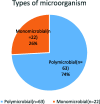Abscesses in different body sites among children: a single-center prospective study
- PMID: 39360384
- PMCID: PMC11456201
- DOI: 10.1177/03000605241281678
Abscesses in different body sites among children: a single-center prospective study
Abstract
Objectives: An abscess is a localized collection of pus contained within a fibrous capsule. In this study, we aimed to determine the demographic pattern, common anatomical sites, risk factors, and the microbial profile of abscesses in different body sites among children.
Methods: We conducted a prospective study in our pediatric surgical department among children with abscesses in different body sites between January 2019 and December 2022.
Results: During the study period, 85 children were included. The participant age range was 0 to 14 years old, and 66% of participants were boys. The most common anatomical sites where abscesses formed were the pelvis (n = 29, 34%), abdomen (n = 22, 26%), neck (n = 14, 16%), and extremities (n = 12, 14%). Risk factors of abscesses in different body sites included cannulation, lymphadenitis, mastitis, perforated appendix, and perianal fistula. We observed that 74% of abscesses were of a polymicrobial nature.
Conclusion: The most common anatomical sites for abscesses in children included the pelvis, abdomen, neck, and extremities. Most abscesses in these sites were polymicrobial in nature.
Keywords: Abscess; aerobic; anaerobic; children; polymicrobial; prospective study; risk factor.
Conflict of interest statement
The authors declare that there is no conflict of interest.
Figures
Similar articles
-
Deep neck space abscesses in children below 5 years of age and their complications.Int J Pediatr Otorhinolaryngol. 2018 Jun;109:40-43. doi: 10.1016/j.ijporl.2018.03.022. Epub 2018 Mar 24. Int J Pediatr Otorhinolaryngol. 2018. PMID: 29728182
-
Acute pediatric neck infections: Outcomes in a seven-year series.Int J Pediatr Otorhinolaryngol. 2017 Aug;99:128-134. doi: 10.1016/j.ijporl.2017.05.020. Epub 2017 May 29. Int J Pediatr Otorhinolaryngol. 2017. PMID: 28688554
-
Microbiology of abscesses of the head and neck in children.Ann Otol Rhinol Laryngol. 1987 Jul-Aug;96(4):429-33. doi: 10.1177/000348948709600416. Ann Otol Rhinol Laryngol. 1987. PMID: 3619288
-
Microbiology of polymicrobial abscesses and implications for therapy.J Antimicrob Chemother. 2002 Dec;50(6):805-10. doi: 10.1093/jac/dkg009. J Antimicrob Chemother. 2002. PMID: 12460997 Review.
-
Perianal Abscesses and Fistulas in Infants and Children.Eur J Pediatr Surg. 2020 Oct;30(5):386-390. doi: 10.1055/s-0040-1716726. Epub 2020 Sep 28. Eur J Pediatr Surg. 2020. PMID: 32987435 Review.
References
-
- Gupta S, Ghosh RR, Bandyopadhyay M. Microbiological profile of abscesses of different body sites in a tertiary care hospital-the silent killer. Asian Journal of Medical Sciences 2023; 14.
-
- Sharma R, Anuradha ND. Bacteriological profile and antimicrobial sensitivity pattern in sterile body fluids from a tertiary care hospital. J Appl Microbiol Biochem 2017; 1: 1.
-
- Brook I. Microbiology of polymicrobial abscesses and implications for therapy. J Antimicrob Chemother 2002; 50: 805–810. - PubMed
-
- Von Elm E, Altman DG, Egger M, et al.. The Strengthening the Reporting of Observational Studies in Epidemiology (STROBE) statement: guidelines for reporting observational studies. Ann Intern Med 2007; 147: 573–577. - PubMed
-
- Kumar A, Srinivasan S, Sharma AK. Pyogenic liver abscess in children—South Indian experiences. J Pediatr Surg 1998; 33: 417–421. - PubMed
MeSH terms
LinkOut - more resources
Full Text Sources
Medical



